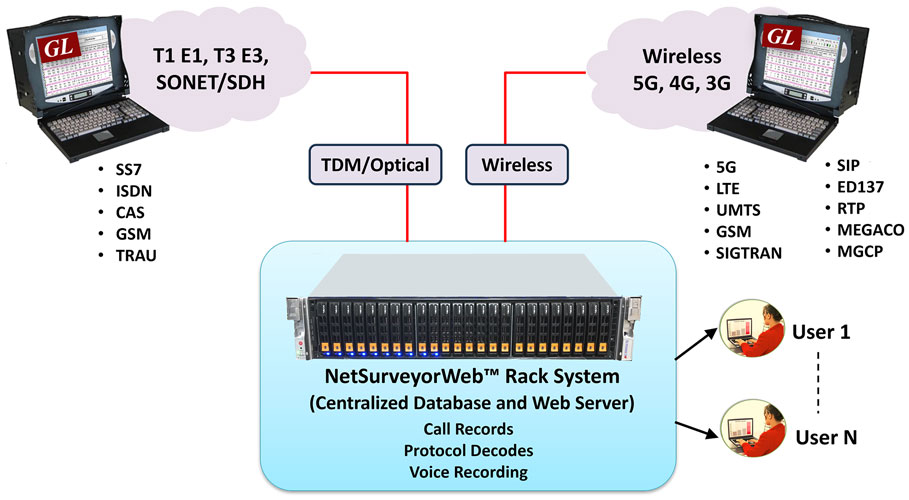Network Surveillance System
Web based centralized network surveillance system for IP, Wireless, and TDM Networks
BROCHURE

Live Demo
NetSurveyorWeb™
GL’s Passive Network Monitoring and Diagnostic Systems support operators, and service providers to perform all the above functions. The network monitoring systems facilitate real-time analysis, historical storage, retrieval, querying, and display of Call Detail Records (CDRs) by non-intrusively connecting to TDM, Optical, or IP networks. Currently supported protocols include LTE, IMS, UMTS IuCS, UMTS IuPS, VoIP (SIP, SIGTRAN, H.323, MAP, CAP, MGCP, MEGACO), SS7, ISDN, CAS, TRAU and GSM.
LIVE DEMO
Overview
The network backbone contains a wealth of information that can be monitored and collected to support diagnostic, troubleshooting, and fraud prevention activities. Surveillance of network characteristics is becoming more important than ever before. Few important aspects of network surveillance include, Performance Monitoring, Security, Fraud Prevention, Physical Layer monitoring, Billing Verification, Remote Protocol Analysis, Failure Prediction, Traffic Engineering, Call Quality Monitoring and Troubleshooting.
GL’s Passive Network Monitoring and Diagnostic Systems support operators, and service providers to perform all the above functions. The network monitoring systems facilitate real-time analysis, historical storage, retrieval, querying, and display of Call Detail Records (CDRs) by non-intrusively connecting to TDM/Analog, Optical, or IP networks. Currently supported protocols include LTE, IMS, UMTS IuCS, UMTS IuPS, VoIP (SIP, SIGTRAN, H.323, MAP, CAP, MGCP, MEGACO, ED-137), SS7, ISDN, CAS, TRAU, GSM, and Analog Systems.
Typically, the surveillance system requires TDM and IP protocol analysis probes deployed at various physical locations. These probes capture, decode, and segregate the traffic to calls and forwards the CDRs, signaling frame details, and other statistics to the centralized database server.
The central system comprises of a database engine, web server, and NetSurveyorWeb™ (PKV170), a web-based application, to facilitate data storage and retrieval through web browser clients.
GL also offers NetSurveyorWeb™ Lite (PKV169) a cost effective, simple plug & play connection, which is an integrated and simplified web-based system that is distributed at probe level.
GL provides a variety of solutions for network wide monitoring and surveillance solutions. Few of them are outlined below
- IP Network Monitoring and Surveillance System (passive / non-intrusive) - SIP, RTP, H.323, ED-137, SIGTRAN, MAP, CAP, INAP, MGCP, MEGACO
- Wireless Network Monitoring and Surveillance System (passive / non-intrusive) – LTE / VoLTE, Diameter, IMS, UMTS, and GSM
- TDM/Analog and Optical Network Monitoring and Surveillance System (passive / non-intrusive probes) - SS7, ISDN, CAS, GSM, TRAU, and Analog System
- Digital T1 / E1 Line Monitoring, Testing, and Diagnostic System
Key Benefits of NetSurveyorWeb™
- Ability to identify and analyze CDR using Key Performance Indicators (KPI’s)
- Ability to listen to the voice calls; play individual left/right/stereo audio sessions
- Set alarm conditions and generate alerts of different types like email alert, visual alert, audible alert, or even log into tables for future analysis
- Reports are displayed both in tabular and graphical formats; customize reports and graphs based on SQL queries
- Graphs provided for Call Completion Ratio, Answer Call, Answer-Seizure Ratio (ASR), Listening MOS, Conversational MOS, Failure Cause, and Call Duration
- Display real-time data - signaling, traffic and Quality of Service (QoS) performance metrics
- Apply single or complex filters for data analysis; use logical operators between filters
- Ability to support various decode standards like ANSI, ITU, ETSI, 3GPP, for all the supported protocols
- Provides Voice Quality metrics (voice band summary, call graph, voice band events) and Delay measurement (average delay for In and Out direction) along with voice and delay KPIs
- Provides CDR and Key Performance Indicators (KPI) for Analog test systems – C-Notched Noise (CNN) Test, Signal-to-Noise Ratio and Level, Voice Quality Test (VQT POLQA) and Three Tone Slope (Gain Slope)
- Ability to export both graphical and tabular reports view as PDF
- Ability to export the call detail records displayed based on time filter or record index as PDF and CSV
Typical Applications
- Comprehensive analysis from overall network health to detailed protocol monitoring
- Call Detail Records, fraud detection and location, remote protocol analysis and troubleshooting, real-time signaling monitor, traffic optimization engineering, and statistics
- Determine actual call signaling routes to verify network functionality under all situations including congestion and loss of SS7 nodes
- Revenue and billing verification, alarm monitoring, intrusive testing
- Quality of service measurements, call trace and recording

